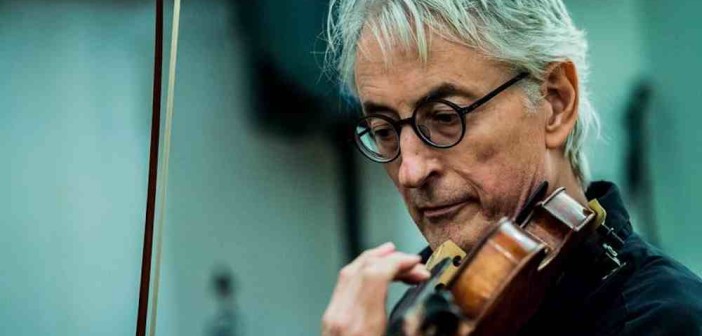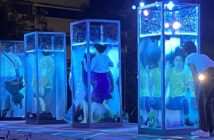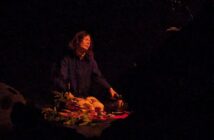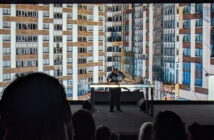The People’s Republic of Australasia is actually SBS subtitling editor, author and publisher Nick Shimmin’s lounge room. On Sunday nights he opens it to concerts by experimental and avant-garde musicians, to audiences on his email list only. It’s a cavernous, warehouse-like space, with a high ceiling, and seating for a capacity of about 80, and a number of paintings, art works, books and records – stored in a 6 storey high carousel – are on display, along with a goldfish pond. It’s BYO, and a selection of books, records and CDs are usually on sale at very reasonable prices. These include Jon Rose’s latest publication, Rosenberg 3.0, not violin music, a compendium of writings by various Rose personae relating to the violin and a number of shibboleths including the mainstream, politicians, virtuosos, orchestras and the piano, published by the fictional Rosenberg Museum.
The People’s Republic has become one of the most lively ‘unofficial’ music venues in Sydney, along with the Café Church in Colbourne Avenue in Glebe on Thursdays – also BYO, but with an entry price, and more of a jazz repertoire. Violinist Jon Rose is a regular guest at People’s Republic, in fact he’s described as a ‘mentor’ of the place, and tonight he’s playing a duet with improvising guitarist Julia Reidy, formerly of Gumbo, who’s just returned home from Berlin. She has an array of implements she uses on her guitar, including a drum stick, steel wool, various metal objects, and what looks like a computer mouse but turns out to be a bottle of blue fluid. Both she and Rose play electrified instruments, and sometimes it’s difficult to tell which is which, with Rose alternating between bowing, plucking and hitting the wood. Both musicians provide a dazzling array of amplified sounds, few of them conventionally associated with either instrument, and an intense level of interaction.
The second part of the evening consists of Rose responding to a half-hour mashup from a film of his major work Great Fences of Australia, in which he and his partner, American violinist and bird researcher Hollis Taylor, dressed like beekeepers in insect-protecting gauze, travelled around Australia playing famous fences in the outback such as the Rabbit Proof fence, Dingo Fence, Melba Fence (at the Victorian Arts Centre), and various Dog Fences with their cello bows, often with fingering as well. (The CD of the recording comes in a box containing a section of rusty barbed wire). Rose’s response to different sections of the film offer a commentary on what he has described as ‘music of distance, boundaries and borders’. The CD was originally released in 2002, and its range covered 35,000 miles of the outback. It has been described at length in Hollis Taylor’s 2007 book, with colour photos and a DVD, Post Impressions: a travel book for tragic intellectuals, which concludes by contemplating Aboriginal songlines, after the couple perform on a fence the posts of which have been painted by three Aboriginal women with animals, flowers, bushes and dragonflies : ‘It sets me reflecting on how it might have been here when every feature of the landscape was woven into song. This land was a giant travel book … a natural science book. The great Australian songbook stretched back and forward in time. And then it snapped.’ As Rose said, when he initially started playing fences in 1983, while he was composer in residence in Perth: ‘I saw fences purely in terms of sonic material. Indeed, that was the conceit: Australia was not covered with millions of miles of fences—it was criss-crossed with a network of string instruments waiting to be bowed’. But the project soon took on a more metaphorical and political significance: ‘As symbol and tool of division, conquest, ownership, hegemony, and paranoia, you cannot find a better exemplar of the species problem. … Fence music often encapsulates the vastness of border country; it is the music of distance. … Playing a fence is risky business. Apart from the possibility that a border guard might try to shorten your life, classically trained musicians are not usually game enough to exchange a tried and tested violin for the unreliable response of fence wire or even barbed wire’. The project has since gone on to expand into Fences of Israel, the Sydney Fence, the Finland Fence, the Mexico-US Border Fence, the Wogarno Fence, the White Cliffs Fence, and the Exmouth Community Fence.
Rose started playing violin at the age of 7, and dropped a school-owned instrument, whereupon it broke into 70 different parts, which his father glued back for him. This gave him an early insight into the mechanics of the instrument, and when he returned to it at the age of 15 he was determined not to play it in any conventional way. When he emigrated to Australia, he was impressed that this country was relatively ‘baggage free’ as far as music was concerned. (This is a feature that Sydney improvisers the Necks have also commented on, the fact that their success is at least partly due to the lack of a jazz ‘tradition’ in Australia, and their freedom to invent their own path. Necks pianist Chris Abrahams and drummer Tony Buck have both performed with Rose and been influenced by him.) In 1977, Rose started Fringe Benefit, Australia’s first musician-run collective for the promotion and recording of improvised music. They initially played lots of concerts in small venues to audiences of 15 to 20 people, and released voluminous quantities of cassettes, which are now collectors’ items. One of his most distinctive early performances was on the awning of Exiles Bookshop on Oxford Street, the recording of which includes the screaming tyres of a passing car braking in surprise. He linked up with like-minded musicians such as Jim Denley and Rik Rue and formed the Relative Band in 1984, so-called as it had a fluctuating membership, and there was a Relative Band festival in Perth. For a while he lived on the island of Dangar on the Hawkesbury river, building instruments and experimenting with violins of all descriptions.
He spent the years 1986 to 2001 in Berlin, where he created an alter ego, the East German maestro Dr Johannes Rosenberg, playing violin beside the Berlin Wall in 1988, and creating the Rosenberg museum in Slovakia, along with numerous other projects committed to video. He pioneered the use of the MIDI bow in the Hyperstring project in the 1980s in conjunction with the Steim Institute, Amsterdam, and more recently premiered his interactive multi-media commission Internal Combustion for violin and orchestra at The Berlin Philharmonic. He published two books, The Pink Violin and Violin in the Age of Shopping (1995, also a CD release) http://www.jonroseweb.com/f_projects_shopping.html, the concept for the second deriving from the idea that after the death of communism and capitalism will come the age of consumerism. He also formed a trio, Strike, with Berlin-based Australian double-bass players Clayton Thomas and Mike Majkowski.
After he won the Don Banks Award in 2012 he was the subject of a multi-stranded, scattershot ABC radio program by Jane Ulman, Out There, the title of which can be interpreted literally as well as figuratively. One of Rose’s more eccentric concert hall appearances was with the BBC Scottish Symphony Orchestra in 2009, playing the last movement of Tchaikovsky’s violin concerto chosen by Canadian ‘plunderphonics’ musician John Oswald, in which Rose improvised along with the orchestra. As he noted on receiving the Banks award, currently held by Mike Nock: ‘paradoxically the audience for improvised music has shrunk even smaller as the amount of improvisers and improvisational languages has grown exponentially’. Nevertheless the list of international musicians Rose has recorded (on over 60 albums) or played with reads like a who’s who of contemporary avant-garde music which constantly breaks boundaries between jazz, classical, contemporary, and outsider music: the Kronos Quartet, John Zorn, Derek Bailey, Butch Morris, Barry Guy, Fred Frith, Chris Cutler, Otomo Yoshihide, KK Null, Toshinori Kondo, Alvin Curran, Evan Parker, John Cage, Tony Oxley, Steve Beresford, Eugene Chadbourne, Shelley Hirsch, Bob Ostertag, Barre Phillips, George Lewis, Alex Von Schlippenbach, Misha Mengelberg, Christian Marclay, Pierre Henry, John Oswald, Veryan Weston … and they’re only the ones I happen to have heard of. That list straddles British, German and Dutch jazz improvisers, Japanese noise musicians and what Rose has called rather cheekily, given Zorn’s outspoken Jewishness, ‘the New York genre cutup scene of which John Zorn became the überfuhrer’ (http://www.jonroseweb.com/.) He recently returned from New York where he played a one-week residency at Zorn’s The Stone, a not-for-profit artist’s space in the East Village.
What Rose has brought to all these musicians is his mastery of almost every conceivable type of unconventional approach to the violin. These include the double piston, triple neck wheeling violin, 10-string double violin, the 19-string cello (which requires two bows) the bicycle-powered double violin, the washing machine engine-powered violin, the 8-string tenor ‘bird’ violin, developed by local violin maker Harry Vatiliotis, the Aeolian double-neck sail violin, which is suspended between two trees, and his development of the interactive violin bow, or K-Bow. This amounts to what he has called a ‘Gesamtkunstwerk of the violin’. He has transformed sports such as netball games into musical and mixed-media compositions (Team Music), composed pieces for kites and kayaks, devised a giant environmental electronic ball piece (Sphere of Influence) at the Art Gallery of NSW in 2007, played by the audience, and developed a whole chamber orchestra of bicycle-powered musical instruments, Pursuit, which was revived in 2013 as part of the Centenary of Canberra celebrations. David Harrington of the Kronos Quartet has described him as ‘the violinist’s cosmologist’, and commissioned Kronos’ performance of Music for 4 Fences, a concert hall segment performed in 2009 at the Sydney Opera House, a far cry from its original performance.
John Whiteoak, author of Playing Ad Lib, a history of Australian improvised music since 1836 which stops just before Rose arrived in Australia from the UK in 1976, has referred to him as ‘the Percy Grainger of our times – the most original musical mind we can point to as our own’. While Rose is not into whips, S&M, incest, racism or the other dubious pursuits that Grainger was, he has written that ‘Grainger’s brain, like classic quantum interference was a crucible of contradictions where phantom or real alternatives could be both child-like and monstrous at the same time’. It’s Grainger’s more child-like devotion to Free Music and beatless music that chimes with many of Rose’s pursuits. Whiteoak’s book was the source of inspiration for Australia Ad Lib an ABC-curated website set up by Rose in 2002 featuring ‘a selection of the most iconoclastic, larrikin, do-it-yourself performers working in Australia today.’ These include bush bands, buskers, backyard hackers, Aboriginal mimics of birds and animals, the Tasmanian roadkill drummers, who make percussion instruments out of dead animal parts, and the trio Toy Death, who play electronic childrens’ toys, and have been described as being ‘like the Teletubbies on acid lost in Japan. Cacaphonic and suitably out there.’ It also features the Ntaria Aboriginal Ladies Choir from Hermannsburg, Aboriginal gum leaf music, ‘Danny Boy’ played on an erhu, a livestock auctioneer, a fridge hum player, spanner music, spoon music, along with more well-known Australian outsider musicians such as Warren Burt, Oren Ambarchi, Martin Ng, Pimmon, Lucas Abela, and the Splinter Orchestra. Extracts from this panoply of eccentric and arcane musics and musicians are included on the first CD of Rosin, a 3 CD (plus DVD data disc) 60th Anniversary Collection Box Set compilation of Rose’s work released at the end of 2012.
In a recent musical radio documentary, Not Quite Cricket, accompanied by his violin, and all kinds of other music Rose chronicles the first Australian cricket team, consisting of Aboriginals, to play at Lords Cricket ground in 1868. Taking the perspective of the Aboriginal team, he turns an historical account into music hall comedy, creating a ‘historical intervention’ out of what he sees as a racial freak show, narrated by Yanggendyinanyuk (played by Richard Kennedy). (see Jane Ulman’s review here).
At the end of the People’s Republic concert, Rose announces that he has a project to create ten places like the People’s Republic. He also says he has a stack of CDs to give away to anyone who has bought a book – he and Hollis are planning to move to Alice Springs.




